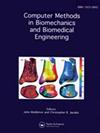Finite element modeling of pedicle screw fixation considering patient-specific bone density.
IF 1.6
4区 医学
Q3 COMPUTER SCIENCE, INTERDISCIPLINARY APPLICATIONS
Computer Methods in Biomechanics and Biomedical Engineering
Pub Date : 2025-09-01
DOI:10.1080/10255842.2025.2552437
引用次数: 0
Abstract
Surgical instrumentation and fusion are necessary in severe cases of spinal deformity. In patients with reduced bone quality, pedicle screw fixation remains challenging due to possible loosening or pullout. The objective was to develop and validate a comprehensive finite element model of pedicle screw fixation considering patient-specific bone density. A bi-planar multi-energy X-ray derived algorithm personalized vertebral bone mechanical properties. It was tested against a reference FEM without patient-specific density (trabecular bone modeled as homogeneous), to assess biomechanical performance. Screw dimensional specifications and trajectory were parametrically modeled, and fixation performance was tested under axial pull-out loads.
考虑患者特定骨密度的椎弓根螺钉固定的有限元建模。
在严重的脊柱畸形病例中,手术固定和融合是必要的。在骨质量降低的患者中,由于可能松动或拔出,椎弓根螺钉固定仍然具有挑战性。目的是开发和验证考虑患者特定骨密度的椎弓根螺钉固定的综合有限元模型。一种双平面多能x线导出算法个性化椎体骨力学特性。将其与没有患者特异性密度的参考FEM(小梁骨模型为均匀)进行对比测试,以评估生物力学性能。对螺杆尺寸规格和轨迹进行了参数化建模,并在轴向拉出载荷下测试了螺杆的固定性能。
本文章由计算机程序翻译,如有差异,请以英文原文为准。
求助全文
约1分钟内获得全文
求助全文
来源期刊
CiteScore
4.10
自引率
6.20%
发文量
179
审稿时长
4-8 weeks
期刊介绍:
The primary aims of Computer Methods in Biomechanics and Biomedical Engineering are to provide a means of communicating the advances being made in the areas of biomechanics and biomedical engineering and to stimulate interest in the continually emerging computer based technologies which are being applied in these multidisciplinary subjects. Computer Methods in Biomechanics and Biomedical Engineering will also provide a focus for the importance of integrating the disciplines of engineering with medical technology and clinical expertise. Such integration will have a major impact on health care in the future.

 求助内容:
求助内容: 应助结果提醒方式:
应助结果提醒方式:


